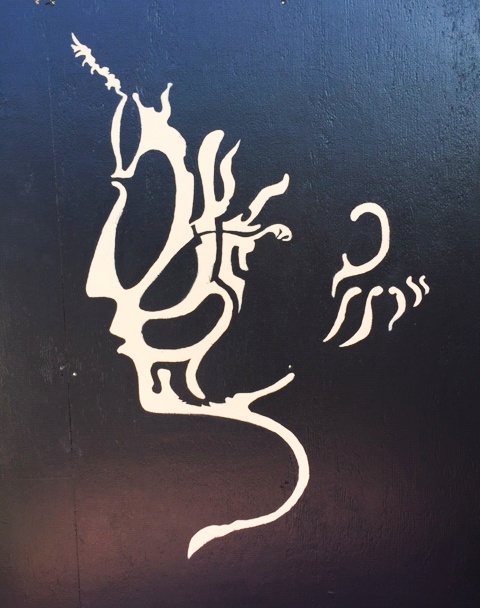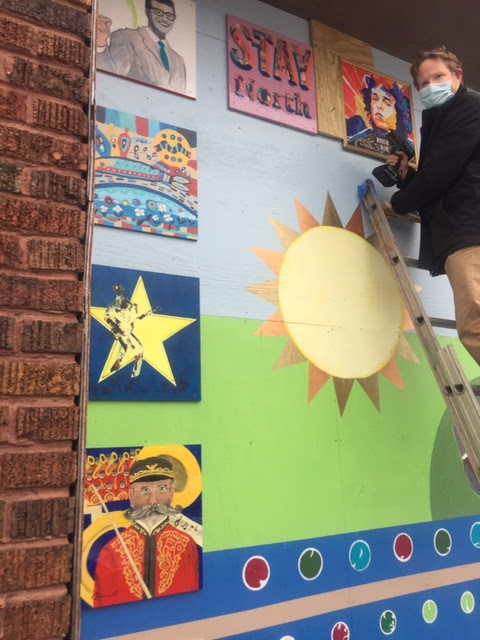 |
| Mark Nicklawski, Michael Shannon, Zane Bale, Mark Poirier Members of the Duluth Dylan Fest Committee Photo credit: Michael Anderson -- Click to enlarge |
Last summer -- and it feels like a decade ago -- Mark Poirier asked me if I'd be interested in doing a mural on a section of Duluth's Historic Armory. Mark is the Armory director who runs the office and manages the building at this point in time. His motive, in part, was to show the public that there were things happening here. For two decades all the renovations have been taking place inside, so it still looked like an abandoned building to many.
 |
| Every mural starts with a blank slate. This one is 17 ft wide & 13 ft tall. |
For those unaware, the Duluth Armory is where young Bobby Zimmerman saw Buddy Holly a few days before Holly died in an Iowa cornfield in Clear Lake, Iowa -- along with the Big Bopper, Ritchie Valens and their pilot.
Although many of us were drawn together through the Duluth Dylan Fest and Bob Dylan Way, it was agreed that the theme should be something broader than a tribute to Bob Dylan.
Because the Armory's history is full of stories, one concept that emerged was to capture and share some of those stories. While I was painting images on the larger wall, a dozen artists worked out different themes to accompany and embellish it. For this reason we see Johnny Cash, Louis Armstrong, Buddy Holly, Sonny & Cher and John Philip Sousa in some of the pictures here. Some of the artists created more abstract impressions.
The wider theme included the manner in which the Armory and its surroundings has been a source of inspiration. One painting, for example, is a tribute to the Anishinaabe peoples who lived on these shores before it became a U.S. territory and later Minnesota.
Each of the artists who contributed was given an 18" x 18" panel which had been precut and primed for painting. One panel (right) lists the artists names in the order that their pieces appear from top to bottom. (Missing from this image are the names of Lulu and Tubbs, who were added when their pieces were delivered later. You can see their paintings to the right of Buddy Holly in the upper left.)
Some of the symbols in the larger mural itself are worth noting. Most of them are related to Bob Dylan, even if he is not a central feature of the painting. Sing Your Song was the title of a documentary on Harry Belafonte that many Duluthians saw at a Duluth Superior Film Festival several years ago. I chose this because when young Bob Dylan arrived in New York City, Wood Guthrie was his idol but his ambition was to be "as big as Harry Belafonte."
As it turns out, young Dylan's first paid recording gig was to play harmonica on a Harry Belafonte album. Though he was lined up to play on three songs, he only recorded one. You can see a photo of the harmonica he played and read the details of that story in Peter McKenzie's Bob Dylan: On a Couch & Fifty Cents a Day.
In the center of the mural is Robert Johnson, who famously made a pact with the devil "down at the crossroads" in Clarksdale, Mississippi at the intersection of Highway 49 and Highway 61, the Blues Highway... which runs North all the way up past the Historic Duluth Armory. To Johnson's right you can see the Highway 61 road sign. (The Clarksdale location is disputed by some who say it took place in Rosedale.)
In the lower right is a funkified Bob Dylan profile that I created.
 |
| Johnny Cash by Kris Nelson |
 |
| Virginia Alexander's Duluth Symphony |
Along the left side you can see (top to bottom) Buddy Holly by Ed Newman, Sue Rauschenfels' Anishinaabe-themed piece, Linda Glisson's expression depicting the energy of a concert atmosphere, and Edna Stromquist's John Philip Sousa. Molly Overden's Lighthouse and Seed is just below that .
On the right side of the mural one can see Christie Eliason's Louis Armstrong at the top followed by Virginia Alexander's Duluth Symphony, Kris Nelson's Johnny Cash, Margie Helstrom's Blues Inspiration and Rosemary Guttormsson's Sonny & Cher.
Here's the current status of the mural.
If you look close, on the right side it says:
TO BE CONTINUED.
Trivia: When I was in college I did an 8' x 12' painting which I
continuously worked on and reconfigured or 3 to 5 hours a day.
It had a life of its own, or so I theorized. I enjoy working large,
as many painters do. This is the objective I have in mind here,
to keep it alive until the time that it must depart. Which means
I need to continue working on it sometime and breathe more
life into it. In the meantime...
THANK YOU TO ALL THE ARTISTS WHO HELPED
BRING THIS PROJECT TO LIFE.
And to the Armory folks who gave us this space to decorate.
















2 comments:
Groovy, man.
What a beautiful tribute! If there is some room left somewhere in this building my friend Laurette Mailllet and me we are ready for another wall painting!
Post a Comment